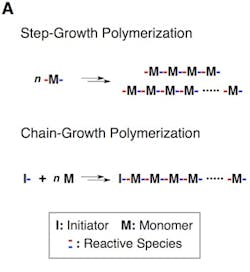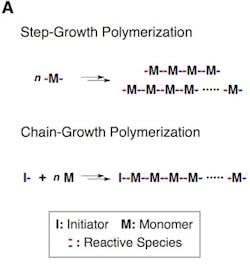Polymer Grows a Different Way
A novel method for creating polymers promises a number of important advantages, believe researchers at the RIKEN Center for Emergent Matter Science, Saitama, Japan. They have developed a technique for building supramolecular polymers that enables close control of chain length and chirality. Moreover, disassembly of the chains is easy, fostering recycling.
In supramolecular polymers, monomers are connected by hydrogen bonds and other weak interactions rather than through chemical reactions. The Japanese researchers discovered how to add monomers to only one end of the chain, so-called chain-growth polymerization, in contrast to conventional step-growth polymerization (Figure 1). The polymerization takes place at ambient temperature and atmospheric pressure and without the need for specialized equipment.
Figure 1 . Unlike conventional step-growth polymerization (top), chain-growth polymerization (bottom) adds monomers only at one end. Source: RIKEN.
In the technique, a mixture of initiator and monomer are added to a solvent; polymerization won’t occur if the initiator isn’t present. The initiator restricts monomer attachment to one end of the chain. Adjusting the proportion of initiator and monomer enables precise control of chain length — a monomer-to-initiator ratio of 1,000:1 allows creation of polymers containing 1,000 monomers. In addition, by selecting an initiator with specific chirality to the solvent, the method yields polymers with that chirality. More details appear in a recent article in the journal Science.
“What is exciting is that, based on lessons from polymer chemistry, we were able to build these macromolecular polymers in a chain-growth rather than step-growth fashion. This has made it possible to control the length of chains, the sequence of molecules, and even the stereochemical structure…,” says Daigo Miyajima, a member of the research team and co-lead author of the article.
“The next step is to seek… promising supramolecular polymers for applications through the optimization of chain length, sequence and molecular design of polymers. Scaling-up follows after that step,” he adds. “We have already started to investigate the physical properties of obtained supramolecular polymers. We expect we can develop a few promising candidates within a few years.”
One of the unique characteristics of supramolecular polymers is that their shapes are akin to nanofibers and this structure can be useful for device fabrication at nanoscale, explains Miyajima.
“Supramolecular structures can have semiconducting properties if properly designed, so this method could be used to reduce the size of transistors. In addition, we found that the polymers can be easily disassembled, with almost 100% yield, so materials produced through this method will be completely recyclable,” he notes.
Despite the easy disassembly of the polymers, their applications aren’t limited to those with short lives, Miyajima says.
Covalently attaching initiators to the surface of an inorganic substrate can enable adding supramolecular polymers to the surface, which may lead to novel applications, he adds.
The current method only works properly if monomers can form intramolecular H-bonds. A key challenge, according to Miyajima, is developing a more general strategy applicable to all supramolecular polymers.

